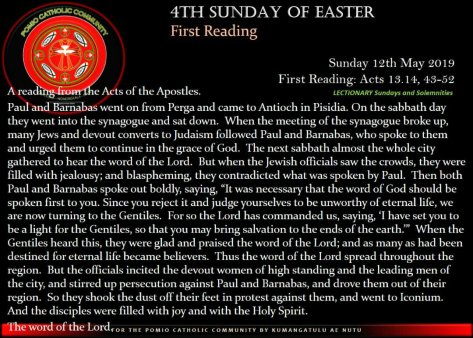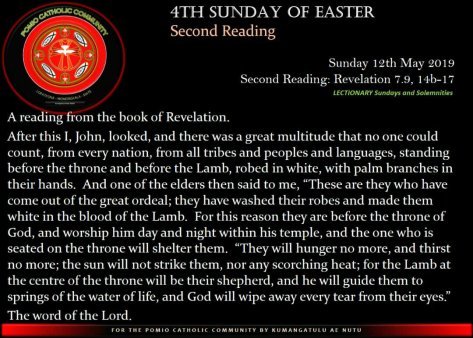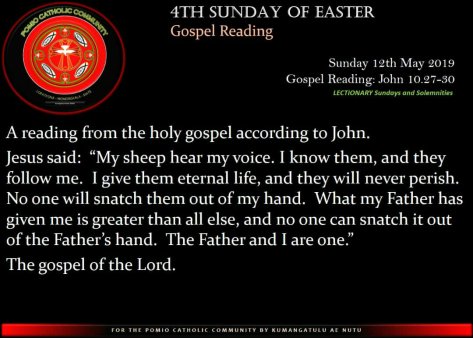“…We are God’s people, the sheep of his flock… ”




“…We are God’s people, the sheep of his flock… ”




Written by Jim Van Vurst, OFM | 2/4/19 12:00 PM
Lent presents to us God’s infinite love for all humankind. So many teachings in the gospel emphasize the mercy of God, which is surely one of the reasons the Gospels are constantly read.
Most never tire of the Parable of the Prodigal Son, our Gospel for the fourth Sunday of Lent (Lk 15:1-32). The scene is so easy to picture in our minds. The son has taken off on his own, expecting to set the world on fire, and in the end he is the one who gets burned. He has dishonored his father in a most horrific way.
By taking his share of the inheritance before his father dies, he has in so many words said to his father, “As far as I’m concerned, you’re dead now. I want out.”Jesus described the father’s longing to see his son again, sitting by the road day after day. When the son finally came to his senses and journeyed home, the father’s heart leaped for joy. He doesn’t force his prodigal to crawl to him on his knees. Rather, the father runs down the hill to reach his son without delay.
Meanwhile, the son is already practicing his apology, asking only that he be given the lowly status of a servant. The father not only welcomes him back without recrimination, but he embraces him and calls for a marvelous feast. Many listeners were not pleased with this parable of Jesus. Likewise even today some are not happy. They say the father was too kind. Where was the justice, the penalty, the “payback”? The father left that bad son “off the hook.” That is why only Jesus could tell that parable; no one else but he would have thought that way.
God is always doing the opposite of what many think he should do. If we are wise, all of us would relish this mercy of God, illustrated in Jesus’ parable.
Of course this parable was spoken by Jesus because he wanted his listeners and in particular his disciples to take to heart. When it comes to sin, we are the prodigal son or daughter. When it comes to forgiveness, we are to be like the prodigal’s father (or mother).
A Difficult Job
First, we need to understand what it really is. And let’s face it. Forgiving real hurt is more difficult than fasting, doing other penances or going to Church and saying our prayers.
It is important to realize just where it resides. To begin with, forgiveness is not a feeling or an emotion; it is a decision we make even when our feelings are charged with anger.
It comes from our will. We may feel like we don’t mean it when it is offered. We easily judge ourselves by our feelings rather than by the decisions we make. But if we say the words, “I forgive” and pray for that offender, we do indeed forgive. To forgive often includes an act of faith in trusting we mean what we say.
True forgiveness is not given on condition that the person apologizes. Our forgiveness may be rejected. We don’t forgive in order to get something back. It may or may not happen. It is given because it is the good and the right thing to do; it is what Jesus asked us to do: “Forgive one another.”
It is taking a risk of being hurt again.
At the same time, it includes accepting an apology if and when it is given. Don’t be surprised if some feelings of hurt, even resentment, may linger after forgiveness. That struggle is part of our woundedness.
It means choosing to love another who by rights doesn’t seem to deserve it. Remember, this act of grace is about compassion rather than justice.
After saying all this, it’s no wonder that our willingness to forgive is the most perfect way of thanking God for the grace we have experienced in our own love. God’s mercy is not to be hoarded by us; it is to be shared.
Jesus Was God
Yes, Jesus was God, so we might say it was “easy” for him to forgive. The truth is that he experienced life on earth through his human nature. He gave up, as Paul tells us, “what it was like to feel like God.” On the cross, his whole body was filled with terrible pain. He felt rejected and hated.
But, a most important point: God shares his mercy with us that we may share it with others. In the most difficult forgiving situations, Jesus tells us: “Come to me, you who are burdened….” The grace we impart is from the font of God’s love for us. He would never command us to forgive and not give us, if we ask in faith and trust, the grace and strength to forgive.
This reflection is adapted from an article in St. Anthony Messenger .
“Blow the trumpet […] sanctify a fast” (Joel 2:15), says the prophet in the first reading. Lent opens with a piercing sound, that of a trumpet that does not please the ears, but instead proclaims a fast. It is a loud sound that seeks to slow down our life, which is so fast-paced, yet often directionless. It is a summons to stop – a “halt!” –, to focus on what is essential, to fast from the unnecessary things that distract us. It is a wake-up call for the soul.
This wake-up call is accompanied by the message that the Lord proclaims through the lips of the prophet, a short and heartfelt message: “Return to me” (v 12). To return. If we have to return, it means that we have wandered off. Lent is the time to rediscover the direction of life. Because in life’s journey, as in every journey, what really matters is not to lose sight of the goal. If what interests us as we travel, however, is looking at the scenery or stopping to eat, we will not get far. We should ask ourselves: On the journey of life, do I seek the way forward? Or am I satisfied with living in the moment and thinking only of feeling good, solving some problems and having fun? What is the path? Is it the search for health, which many today say comes first but which eventually passes? Could it be possessions and wellbeing? But we are not in the world for this. Return to me, says the Lord. To me. The Lord is the goal of our journey in this world. The direction must lead to him.
Today we have been offered a sign that will help us find our direction: the head marked by ash. It is a sign that causes us to consider what occupies our mind. Our thoughts often focus on transient things, which come and go. The small mark of ash, which we will receive, is a subtle yet real reminder that of the many things occupying our thoughts, that we chase after and worry about every day, nothing will remain. No matter how hard we work, we will take no wealth with us from this life. Earthly realities fade away like dust in the wind. Possessions are temporary, power passes, success wanes. The culture of appearanceprevalent today, which persuades us to live for passing things, is a great deception. It is like a blaze: once ended, only ash remains. Lent is the time to free ourselves from the illusion of chasing after dust. Lent is for rediscovering that we are created for the inextinguishable flame, not for ashes that immediately disappear; for God, not for the world; for the eternity of heaven, not for earthly deceit; for the freedom of the children of God, not for slavery to things. We should ask ourselves today: Where do I stand? Do I live for fire or for ash?
On this Lenten journey, back to what is essential, the Gospel proposes three steps which the Lord invites us to undertake without hypocrisy and pretence: almsgiving, prayer, fasting. What are they for? Almsgiving, prayer and fasting bring us back to the three realities that do not fade away. Prayer reunites us to God; charity, to our neighbour; fasting, to ourselves. God, my neighbour, my life: these are the realities that do not fade away and in which we must invest. Lent, therefore, invites us to focus, first of all on the Almighty, in prayer, which frees us from that horizontal and mundane life where we find time for selfbut forget God. It then invites us to focus on others, with the charity that frees us from the vanity of acquiring and of thinking that things are only good if they are good for me. Finally, Lent invites us to look inside our heart, with fasting, which frees us from attachment to things and from the worldliness that numbs the heart. Prayer, charity, fasting: three investments for a treasure that endures.
Jesus said: “Where your treasure is, there will your heart be also” (Mt 6:21). Our heart always points in some direction: it is like a compass seeking its bearings. We can also compare it to a magnet: it needs to attach itself to something. But if it only attaches itself to earthly things, sooner or later it becomes a slave to them: things to be used become things we serve. Outward appearance, money, a career or hobby: if we live for them, they will become idols that enslave us, sirens that charm us and then cast us adrift. Whereas if our heart is attached to what does not pass away, we rediscover ourselves and are set free. Lent is the time of grace that liberates the heart from vanity. It is a time of healing from addictions that seduce us. It is a time to fix our gaze on what abides.
Where can we fix our gaze, then, throughout this Lenten journey? It is simple: upon the Crucified one. Jesus on the cross is life’s compass, which directs us to heaven. The poverty of the wood, the silence of the Lord, his loving self-emptying show us the necessity of a simpler life, free from anxiety about things. From the cross, Jesus teaches us the great courage involved in renunciation. We will never move forward if we are heavily weighed down. We need to free ourselves from the clutches of consumerism and the snares of selfishness, from always wanting more, from never being satisfied, and from a heart closed to the needs of the poor. Jesus on the wood of the cross burns with love, and calls us to a life that is passionate for him, which is not lost amid the ashes of the world; to a life that burns with charity and is not extinguished in mediocrity. Is it difficult to live as he asks? Yes, it is difficult, but it leads us to our goal. Lent shows us this. It begins with the ashes, but eventually leads us to the fire of Easter night; to the discovery that, in the tomb, the body of Jesus does not turn to ashes, but rises gloriously. This is true also for us, who are dust. If we, with our weaknesses, return to the Lord, if we take the path of love, then we will embrace the life that never ends. And surely we will be full of joy.
https://pomiocatholiccommunity.blogspot.com/2019/03/ash-wednesday-6th-march-2019-homily-of.html
St. John Bosco was a holy priest whose deep spiritual life led to frequent visions or “dreams,” as he would call them. He wrote about one of them in a letter to his students.
The dream occurred on the eve of the Assumption of the Blessed Virgin Mary, and in it a stranger came up to him and asked him to look at something on the ground.
He took me to a meadow alongside the playground and pointed to a huge, ugly snake, over twenty feet Iong, coiled in the grass. Frightened, I wanted to run off, but the stranger held me back. “Get closer and take a good look,” he said.
“What?” I gasped. “Don’t you realize that monster could spring on me and
gobble me up in no time?”
“Don’t be afraid! Nothing of the sort will happen. Just come with me.
The stranger went to get a rope and asked St. John Bosco to slap the snake with the rope.
We stretched the rope and then snapped it across the snake’s back. The monster immediately sprang up and struck at the rope, but, as it did so, it ensnared itself as in a noose.
The snake began to struggle and quickly died. Then the stranger picked up the rope and put it in a box. What happened next was astonishing, and then the stranger explained the spiritual symbolism behind what happened.
Within a few moments he opened the box. We looked in and were astounded to see the rope shaped into the words Ave Maria.
“How did that happen?” I asked.
“The snake,” the man replied, “is a symbol of the devil, whereas the rope stands for Ave Maria or, rather, the Rosary, a succession of Hail Marys with which we can strike, conquer, and destroy all of hell’s demons.”
St. John Bosco took the lesson to heart and wrote to his students, “Let us devoutly say a Hail Mary whenever we are tempted, and we’ll be sure to win.”
The experience confirms what many exorcists have said about the power of the Virgin Mary over the devil. Satan is greatly humiliated by the purity and simplicity of the Blessed Mother and flies as fast as he can whenever he hears her name. It’s a powerful reminder, one that urges us to pray the Rosary devoutly whenever we feel threatened by the Evil One.
_____________________Disclaimer________________________
The information transmitted is intended only for the person or entity
to which it is addressed and may contain confidential and/or
privileged material. Any review, retransmission, dissemination or
other use of, or taking of any action in reliance upon, this information
by persons or entities other than the intended recipient is prohibited.
If you received this in error, please contact the sender and delete
the material from any computer.
You must be logged in to post a comment.